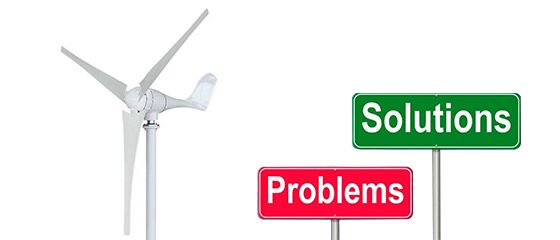Wind Turbine Troubleshooting
A wind turbine is a turbine powered by wind energy. Wind turbines are like air intakes for jet engines. When air enters, it first encounters a set of fixed blades, called the stator, that direct air into a set of rotating blades called the rotor. The air pushes against the rotor and appears on the other side, where it travels more slowly than it would outside the turbine. Not only do we need to understand the definition of a wind turbine, but we also need to think about how to solve some of the problems that arise.

The positioning of the wind turbine is invalid or cannot be adjusted. The resistance of the damper for leeward or rudder adjustment is too high. The tension force of the balance spring for head-turning and head-up speed regulation is small or invalid. The steering motor is out of control or running sickly or its bearing is broken. Anemometer or tachometer generator of the wind turbine may be out of control. The bearing of the steering wheel enters the soil and is poorly lubricated. The resistance is too large or the bearing of the turntable is damaged and cannot be rotated. The instruction of the microcomputer is wrong, and the direction adjustment fails.
Solution: Turn damper spring pressure down. Adjust the balance spring to the rated wind speed and turn your head upwards or tilt your head up. If the spring fails, it needs to be replaced. If the electric control of the start-up steering motor is broken, replace it or replace the motor bearing, and re-install the steering motor. If the stator part of the motor is short-circuited or open, remove it for inspection, re-wire it, and re-install it after repairing. Check the anemometer and tachometer generator, replace if damaged. Check the slewing bearing, remove the soil, clean it and fill with oil, and replace the oil seal. If the turntable bearing is damaged and the nacelle needs to be removed for replacement. At this time, a major overhaul should be carried out, all bearings should be replaced, lubricating oil should be replaced, etc.
There is an abnormal noise when the wind wheel rotates. The engine room is loose or it touches the rotating parts after being loose. The rotor bearing seat is loose or the bearing is damaged. The speed increaser is loose or the gearbox bearing is damaged. The brakes are loose.
Solution: Re-adjust the coaxiality of the wind wheel shaft and the speed increaser, and tighten the fixed bolts firmly. If the bearing is damaged, replace the bearing and re-rotate the bearing seat. Adjust the coaxiality of the speed increaser and re-tighten its fixed bolts. Remove the speed increaser, replace the bearing and oil seal, and re-install the speed increaser. Re-fix the brake and adjust the brake pad clearance.
When the wind speed reaches a certain rated wind speed, the rotor cannot reach the rated speed. There is contract friction between generator rotor and stator. Gearbox bearing or rotor bearing get damaged. The brake pad return spring fails and the brake pads are in a semi-braking state. Microcomputer speed control failure.
Solution: The balance of the aerodynamic speed regulation is broken. The tension should be replaced or adjusted. Find out where the pitch drive system is stuck and eliminate it. If the hydraulically driven variable pitch cylinder is stuck or leaks oil, replace the cylinder or solve the oil leak. The generator bearing is damaged and it should be removed and replaced. If the generator shaft is bent, you need to remove the rotor for straightening or replacement. Remove and replace gearbox bearing or rotor bearing, re-adjust the coaxial angle and install it.

